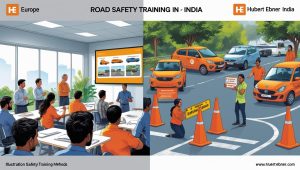Why Ergonomics Matters for Long-Haul Drivers
Long-haul driving requires hours of continuous focus, often in challenging conditions. Poor ergonomics can lead to musculoskeletal issues, fatigue, and decreased alertness, all of which increase the risk of accidents. Proper ergonomic practices help drivers maintain comfort, health, and performance, ensuring safer and more efficient trips.
Hubert Ebner supports awareness-driven content for transportation professionals and apps that track driver health, fatigue, and posture for long-haul safety.
Common Ergonomic Challenges for Long-Haul Drivers
- Prolonged Sitting
- Sitting for hours strains the lower back, hips, and legs.
- Poor seat adjustment or posture can lead to chronic pain and discomfort.
- Repetitive Motions
- Frequent steering, gear shifting, and pedal use can cause strain in wrists, shoulders, and arms.
- Limited Movement
- Restricted space in the cabin can reduce circulation and increase fatigue.
- Incorrect Monitor or Mirror Position
- Misaligned mirrors or dashboard displays force drivers into awkward postures, leading to neck and shoulder strain.
Ergonomic Strategies for Long-Haul Drivers
1. Seat Adjustment
- Adjust the seat so that your knees are slightly bent and feet comfortably reach pedals.
- Use lumbar support cushions to maintain the natural curve of the spine.
- Ensure the seat height allows for a clear view of mirrors and road ahead.
2. Steering Wheel and Controls
- Position the steering wheel at a comfortable distance to avoid overreaching.
- Keep elbows slightly bent for reduced shoulder strain.
- Adjust mirrors to minimize neck rotation and reduce repetitive stress.
3. Breaks and Movement
- Take breaks every 2–3 hours to stretch and walk.
- Perform simple stretches for legs, back, and shoulders during stops.
- Use the break to hydrate and prevent stiffness.
4. Foot and Pedal Positioning
- Keep feet aligned with pedals to reduce ankle and calf strain.
- Avoid crossing legs for long periods to maintain proper circulation.
5. Monitor and Device Placement
- If using GPS or monitoring devices, position screens at eye level to reduce neck strain.
- Avoid holding devices in awkward positions for extended periods.
6. Maintain Healthy Posture
- Sit with shoulders relaxed and back straight.
- Avoid slouching or leaning excessively forward.
- Engage core muscles subtly to support the spine.
Health Benefits of Proper Ergonomics
- Reduced risk of chronic back, neck, and joint pain
- Improved alertness and reaction time
- Decreased fatigue during long drives
- Lower likelihood of developing circulation or nerve issues
- Enhanced overall well-being for long-haul drivers
How Technology Supports Ergonomics
Hubert Ebner enables developers to build apps and platforms that support driver ergonomics and health monitoring, such as:
- Wearable devices tracking posture, heart rate, and fatigue
- Real-time alerts for prolonged sitting or improper posture
- Data analytics to identify risk patterns and recommend improvements
- Integration with route planning apps to schedule optimal rest breaks
Conclusion
For long-haul drivers, ergonomics is not just about comfort—it’s about safety. Implementing proper seating, posture, and movement strategies reduces fatigue, prevents injuries, and improves alertness on the road.
Hubert Ebner empowers organizations and developers to create tech solutions that monitor driver ergonomics, health, and safety, combining data-driven insights with practical recommendations for safer, healthier journeys.




